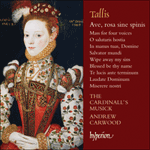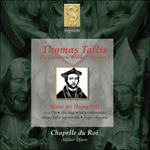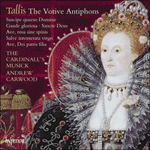
Welcome to Hyperion Records, an independent British classical label devoted to presenting high-quality recordings of music of all styles and from all periods from the twelfth century to the twenty-first.
Hyperion offers both CDs, and downloads in a number of formats. The site is also available in several languages.
Please use the dropdown buttons to set your preferred options, or use the checkbox to accept the defaults.

This prayer shewe[d] oure ladye to a devoute persone sayenge that this golden prayer is the most sweetest et acceptabeleste to me in her aperynge she hadde this salutacyon et prayer wryten with letters of golde on her breste.
The music of Ave, rosa sine spinis is a considerable advance on that found in the four-part Latin Magnificat but it is not as sophisticated as Salve intemerata virgo. It is hard to place Tallis’ works in a chronological order but of those left to us perhaps this is the second or third most youthful. We can with certainty say that it must belong to the period before his return to London as a member of the Chapel Royal in the mid-1540s. Tallis has learned his craft well, having a judicious mixture of sections for solo voices set against full-choir writing and an easy, fluent way with melody. Harmonically it is rather conservative, nearly always cadencing in D minor, but he does venture further abroad in the last section, visiting both the sub-dominant and dominant in the space of ten bars. There is also a fine closing Amen which features an imitative melody reminiscent of the final section of Gaude gloriosa (his final word in the Antiphon tradition).
from notes by Andrew Carwood © 2015
Cette prière montrait notre dame à une dévote personne disant que cette prière dorée est pour moi la plus douce et la plus convenable, avec cette salutation et prière écrite en lettres d’or sur son sein.
La musique d’Ave, rosa sine spinis marque une considérable avancée par rapport à celle du Magnificat latin à quatre parties mais sans la sophistication de Salve intemerata virgo. Il est ardu d’établir une chronologie des œuvres de Tallis mais, de toutes celles qui nous sont parvenues, celle-ci est peut-être la deuxième ou la troisième plus ancienne. Tallis l’écrivit sans nul doute avant de rentrer à Londres, comme membre de la Chapel Royal, dans les années 1545. Il avait bien appris son métier: il dispose un judicieux mélange de sections pour voix solistes sur un fond d’écriture à chœur entier, avec une mélodie facile, fluide. Harmoniquement assez conservatrice, cette pièce cadence presque toujours en ré mineur, sauf dans la dernière section, où Tallis se hasarde à visiter la sous-dominante et la dominante en l’espace de dix mesures. Il y a également un bel Amen conclusif qui présente une mélodie imitative rappelant la section finale de Gaude gloriosa (le dernier mot de Tallis dans la tradition de l’antienne).
extrait des notes rédigées par Andrew Carwood © 2015
Français: Hypérion
Dieses Gebet zeigte unsere Dame, wie sie zu einer frommen Person sagte, dass dieses goldene Gebet das ihr Süßeste und Angenehmste sei. In ihrer Erscheinung hatte sie diesen Gruß und das Gebet mit goldenen Lettern auf ihrer Brust geschrieben.
Die Musik von Ave, rosa sine spinis stellt einen beachtlichen Fortschritt gegenüber dem vierstimmigen Magnificat in lateinischer Sprache dar, ist jedoch nicht so komplex wie Salve intemerata virgo. Es ist nicht einfach, Tallis’ Werke in chronologischer Reihenfolge anzuordnen, doch kann man vielleicht davon ausgehen, dass von den heute überlieferten dieses wohl das zweite oder dritte seiner Jugendwerke ist. Man kann jedoch mit Sicherheit sagen, dass es in der Zeit entstanden sein muss, bevor er Mitte der 1540er Jahre als Mitglied der Chapel Royal nach London zurückkehrte. Tallis hatte sein Handwerk gründlich erlernt—dieses Stück weist eine überlegte Mischung an Abschnitten für Solostimmen und vollchörigen Teilen sowie eine mühelose und flüssige Melodik auf. In harmonischer Hinsicht ist es recht konservativ gehalten und kadenziert fast immer in d-Moll, doch bewegt er sich im letzten Abschnitt in entlegenere Regionen—sowohl die Subdominante als auch die Dominante wird innerhalb von 10 Takten aufgesucht. Das abschließende Amen ist besonders schön gearbeitet und hat eine imitative Melodie, die an den Schlussteil von Gaude gloriosa (sein letztes Werk in der Antiphon-Tradition) erinnert.
aus dem Begleittext von Andrew Carwood © 2015
Deutsch: Viola Scheffel
 Tallis: Ave, rosa sine spinis & other sacred music Tallis: Ave, rosa sine spinis & other sacred musicThe Cardinall’s Musick and their inspirational director Andrew Carwood present a further volume of their Gramophone-Award-winning series of Tallis’s sacred music.» More |
 Tallis: The Complete Works, Vol. 1 Tallis: The Complete Works, Vol. 1This debut album recorded by Chapel du Roi is the first in a series of nine covering the complete works of Thomas Tallis (c1505-1585). Not for nothing is Tallis known as the 'father of church music'—with his colleagues at the Chapel Royal he creat ...» More |
 Tallis: The Votive Antiphons Tallis: The Votive AntiphonsHighlights from Hyperion’s series of Tallis recordings by Andrew Carwood and The Cardinall’s Musick.» More |

